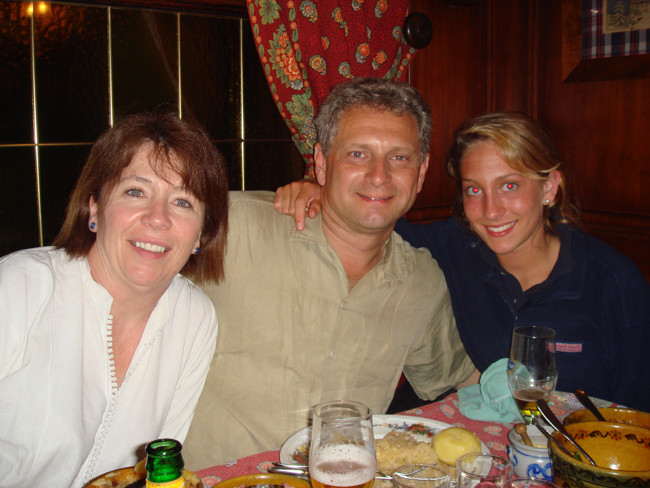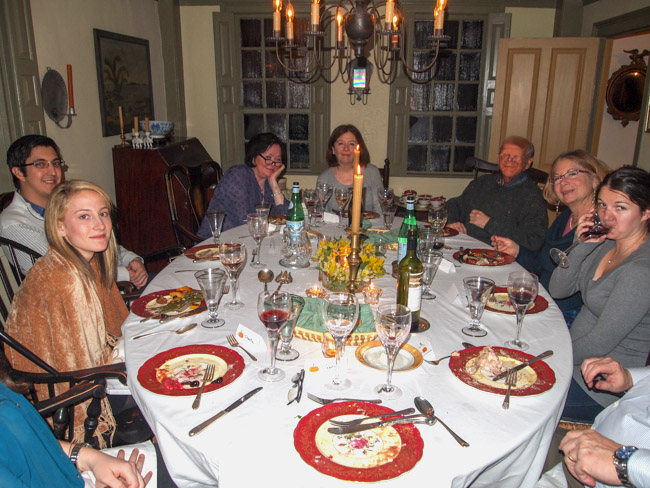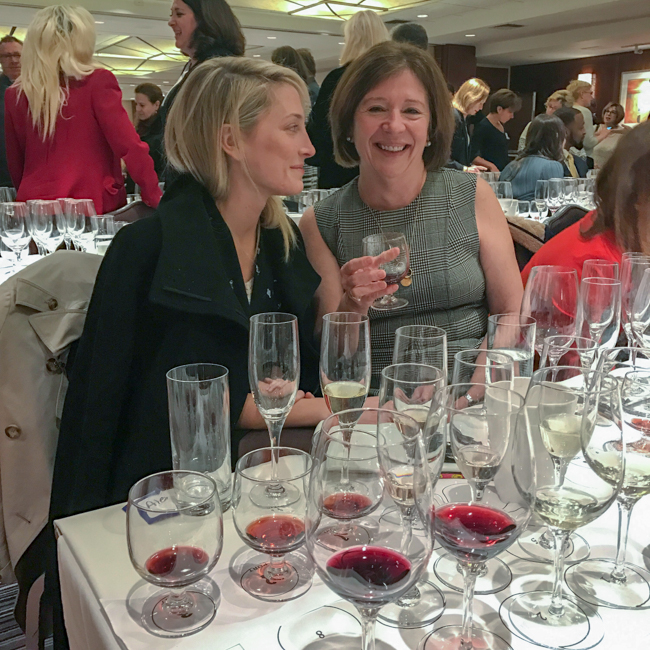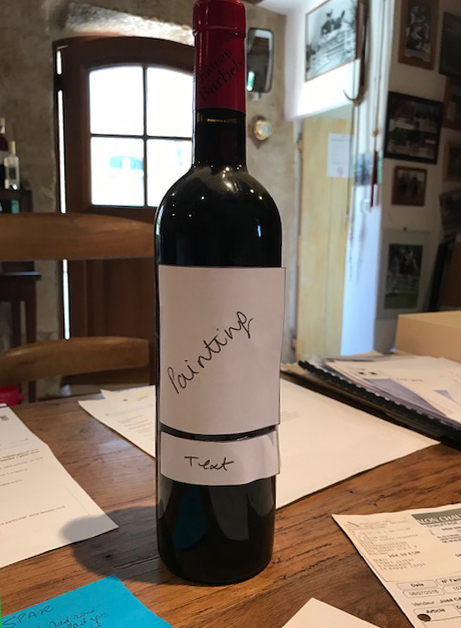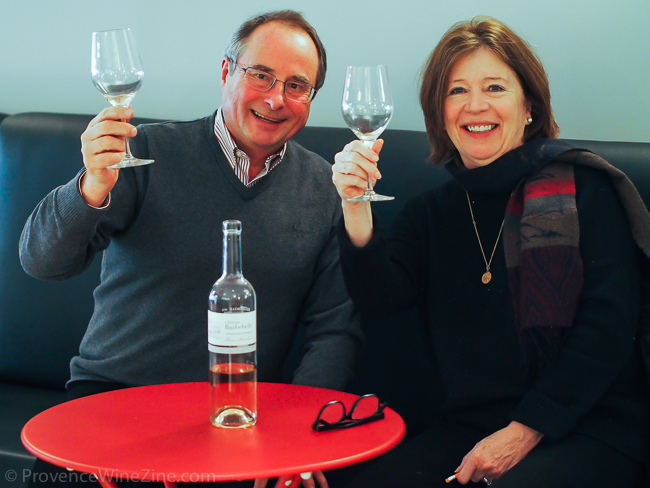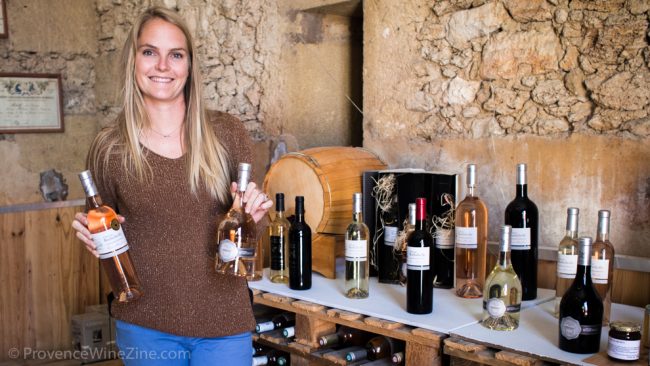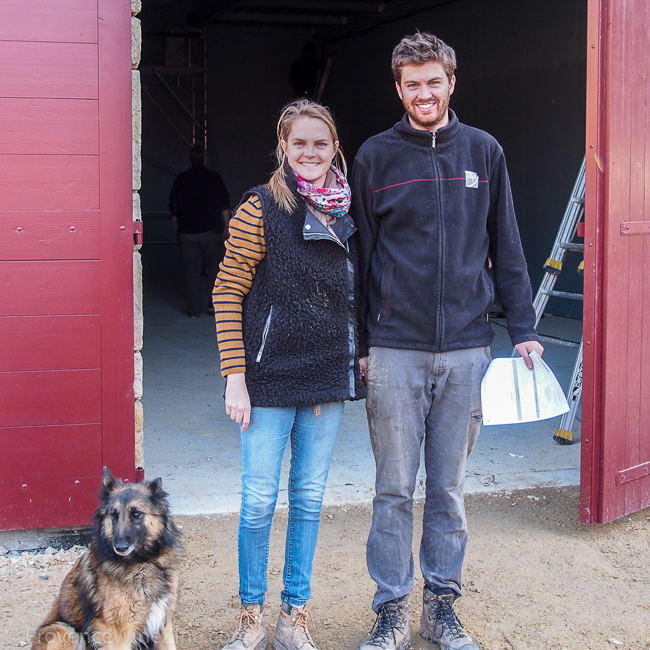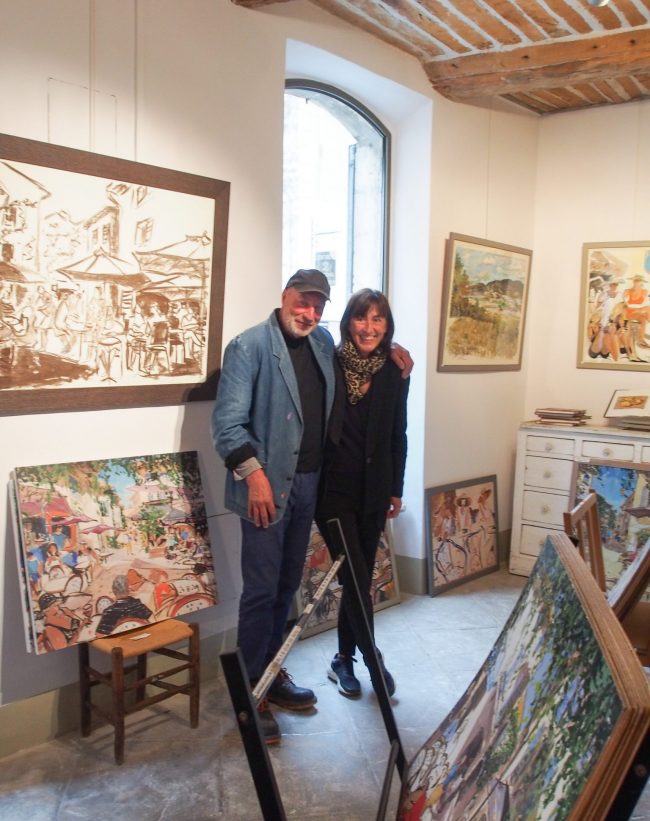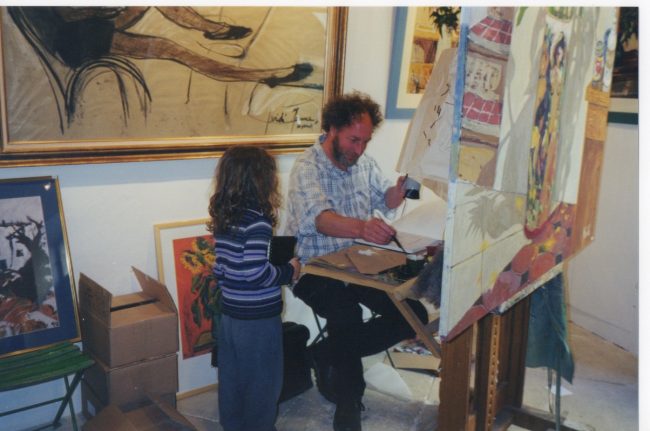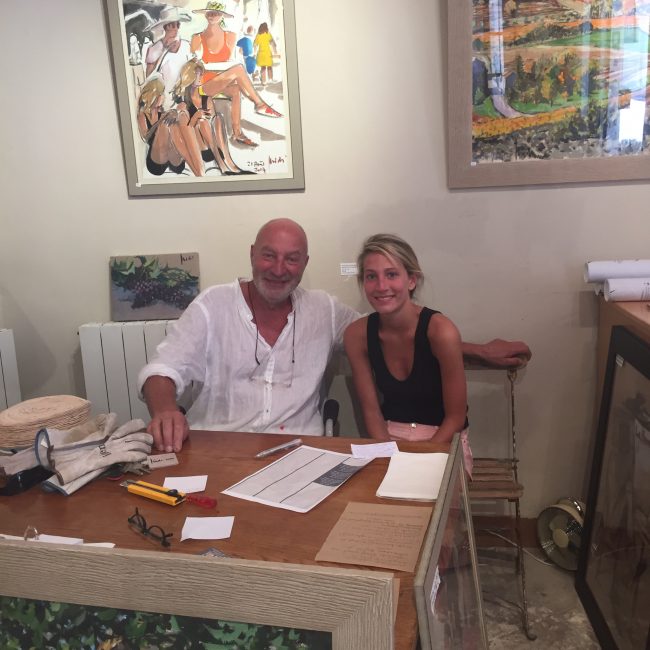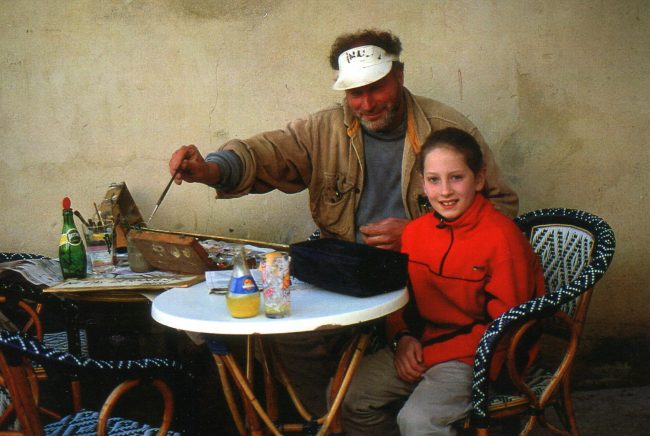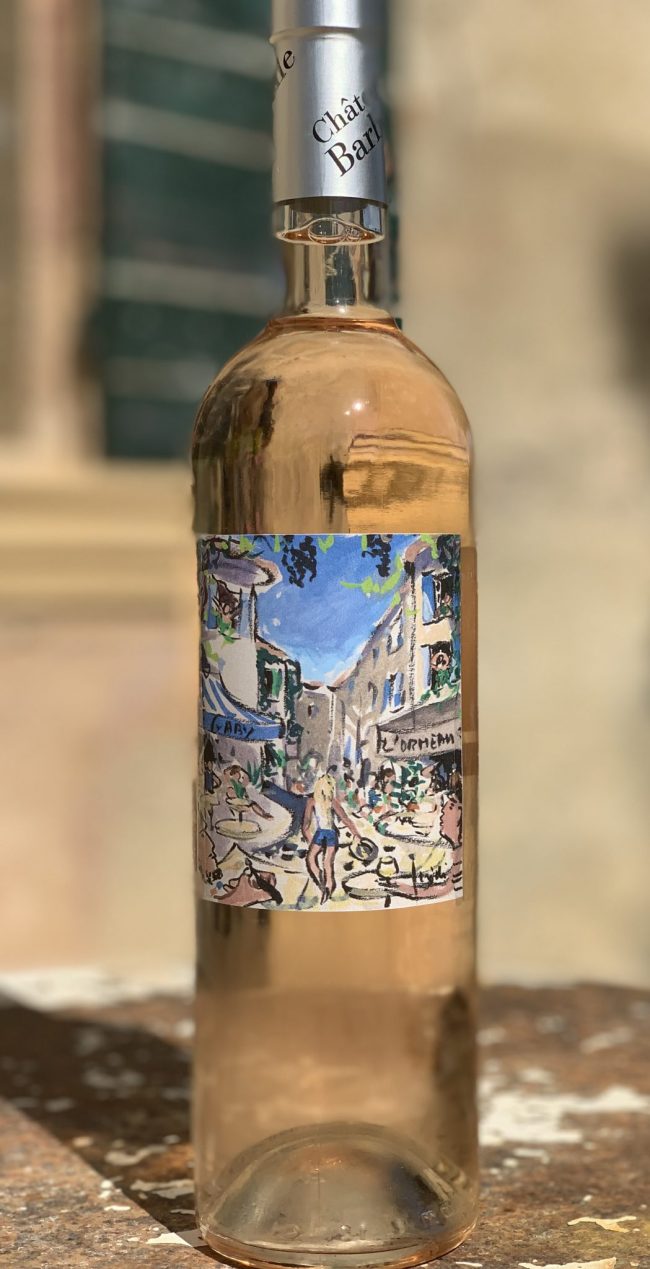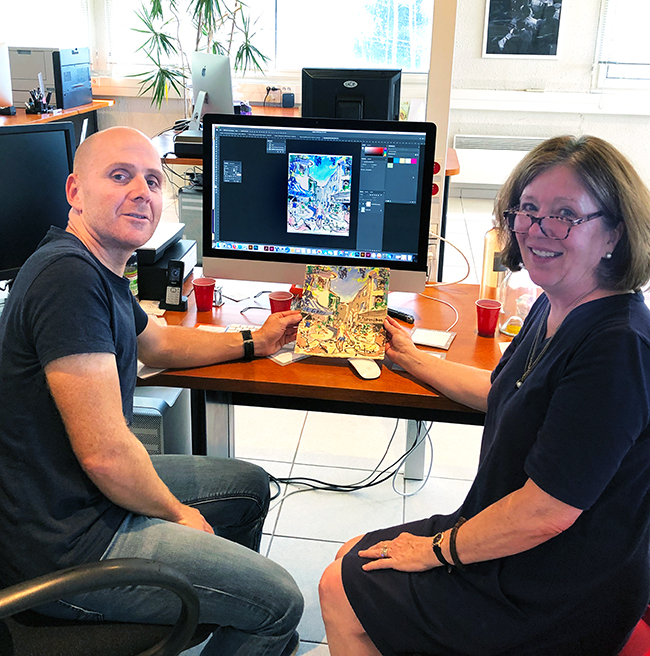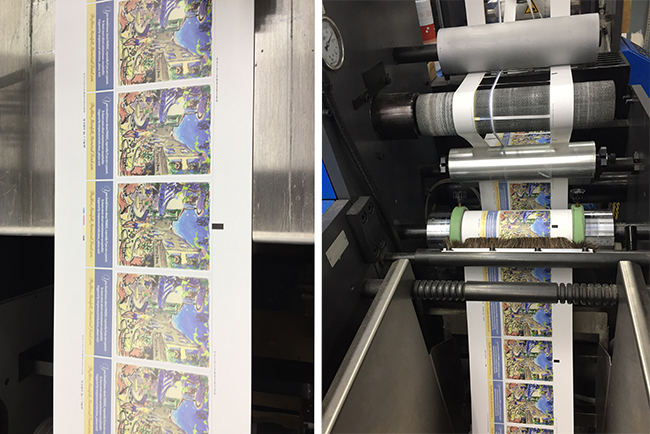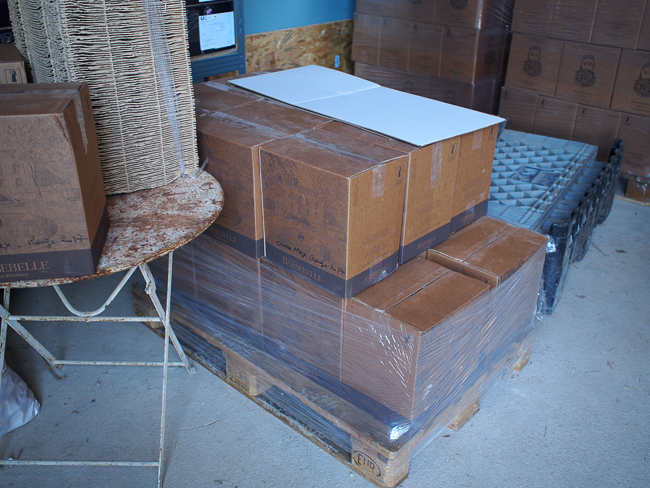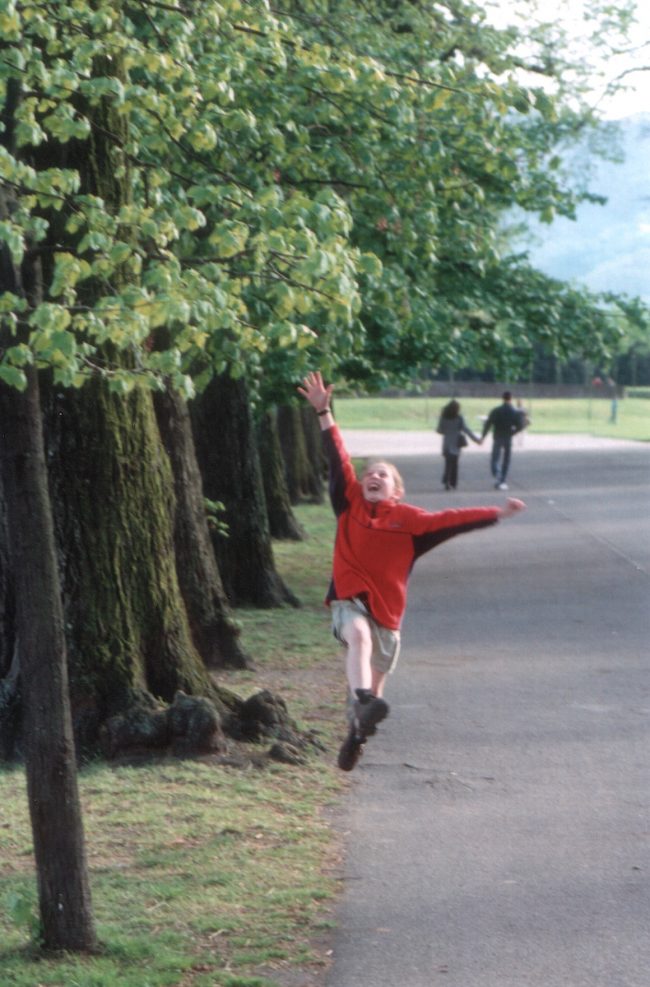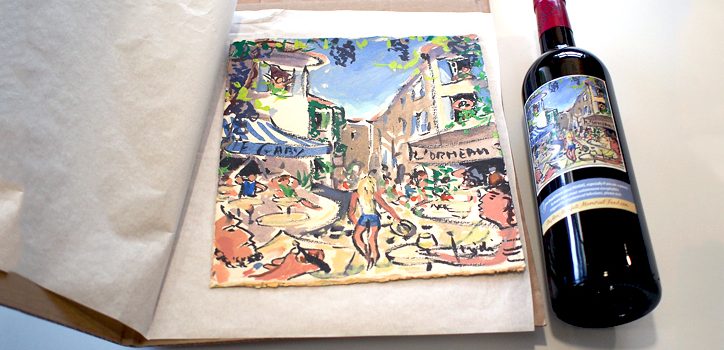 Online Article
Online Article

by Susan Manfull
Published July 23, 2020
The above title would be (more) unwieldy if I included all the names of the friends, family, and strangers who have contributed to making the À Table! project a reality. There are many people to whom my husband and I are deeply grateful. With the launch of this project, more people can help to raise awareness about PANDAS and PANS: purchase a bottle of the wine, made especially for The Alex Manfull Memorial Fund, invite friends and family to your table, and enjoy the wine with a meal as you help spread the word about this horrific disorder. Raise your glass to the defeat of PANDAS and send us a photo that can be posted online on Alex’s birthday, September 7th. All proceeds will go to further research on the causes and treatment of Post-infectious Autoimmune Basal Ganglia Encephalitis disorders such as PANDAS and PANS.
There are no words to describe how my husband and I felt when our 26-year-old daughter, Alexandra “Alex” Manfull, lost her life to PANDAS, a basal ganglia encephalitis disorder triggered by Group A Streptococcus. Devastated may come closest. Alex was our only child and we were a very close family.
When Alex died in August 2018, we barely knew what PANDAS stood for. Nor did most other people, including physicians.
In the days immediately following Alex’s death, I recall feeling as if I was having one long out of body experience. I was watching two people moving, automaton-like, at the direction of others, from one task to the next. Only those two people were us and we were carrying out the endless list of obligatory tasks that surface after someone dies. And the “deceased,” a word that has always made me cringe, was our daughter. How would we ever go on?
What is PANDAS?
PANDAS is characterized by an acute onset of obsessions and compulsions and/or tics following a Group A Streptococcal (GAS) infection. Other symptoms may follow, including, for example: restricted eating, separation anxiety, general anxiety, personality changes, severe mood swings, irritability, sleep disruption, ADHD-type behaviors, dysgraphia, loss of math skills, urinary frequency and incontinence, explosive rage, extreme impulsivity, and suicidal ideation. All symptoms invariably wax and wane.
PANDAS is part of a broader category of disorders called PANS (Pediatric Acute Onset Neuropsychiatric Syndrome) which present in much the same manner, but for which the trigger may not be known.
In some people, after repeated infections, the antibodies produced by the immune system appear to go rogue; they cross the blood-brain barrier and target neurons in the basal ganglia part of the brain, likely causing inflammation and consequent neuropsychiatric symptoms.
Both PANDAS and PANS (aka Basal Ganglia Encephalitis) are more likely to occur in childhood but can and do occur in adolescence and, as was the case with Alex, in adulthood. Why some people are so adversely affected by common diseases such as strep is not fully understood.
Alex received a formal diagnosis of PANDAS — short for Pediatric Autoimmune Neuropsychiatric Disorder Associated with Streptococcus — just a couple of weeks before she died although she had diagnosed herself years earlier. With a name for the seemingly unrelated set of symptoms she increasingly experienced, Alex was elated. She made it clear to everyone she talked to that she was going to write about this disease, telling everyone about it so that no one else would have to go through all that she had to endure. But that mission never began because, just a few days before Alex was set to receive her treatment, she died.
Before my husband and I collapsed into a profound sadness that still, nearly two years later, has the power to paralyze, we told each other that we would carry on with what Alex intended to do: work to make sure that no other person would lose his or her life or the years of life it can take to diagnose and treat this horrendous disease. After all, this is what Alex wanted to do…and had we known more about it, Alex might be here telling her own story.
What is the À Table! project?
À Table! is one of the projects we created to raise awareness about PANDAS. It sounded a bit crazy at first blush, but we got the idea of using bottles of wine to spread the word about the deadly role of strep in causing neuropsychiatric symptoms. Many people know that strep infections can seriously affect the heart, kidneys, skin, and joints (e.g., rheumatic fever, scarlet fever, and even necrotizing fasciitis) but they don’t know how it can lead to very serious inflammatory conditions in the basal ganglia part of the brain. The label on the wine bottle and an attached booklet would contain information about strep and PANDAS (and a related condition called PANS).
À Table! grew out of our family’s tradition of coming to the table for dinner. Translated from French, “À Table!” means, “Come to the table!” Sometimes dinner was a grilled cheese sandwich, or a hotdog wrapped in dough and baked; other nights it was quite fancy, but nearly every night, we three sat around the kitchen table to catch up on the day’s events. Towny often traveled when Alex was growing up so, sometimes, it was just the two of us and, other times, we had so many guests that we moved to the dining room table.
Alex was a busy child, as well as an observant and expressive one, so there was never a lull in the flow of conversation. In the early years, the subjects of conversation ran the gamut from why our Glen of Imaal terrier puppy would want to chew off the tail of Alex’s plastic brontosaurus to which teacher Alex really wanted for second grade. They evolved as Alex grew older, to address more pressing concerns such as how to handle mean girls or a difficult teacher or why those men flew those airplanes into the World Trade Center. When soccer practice and, later, prep school took Alex away from the table on most nights, our gatherings became less regular but no less integral to who we were. Sometimes, the front seat of the car felt more like our dinner table. In those days, the conversations usually revolved around soccer, squash, or coxing. Then, before we knew it, we were discussing college.
Wine almost always came to the table. I learned from my grandfather to pair my meals with wine. It was always a treat to have dinner with my grandparents and, as I grew older and began to appreciate wine, it was particularly fun to see which wine my grandfather, whose business was selling corks and foil capsules for wine bottles, would bring. We often would be the last two at the table. Towny, who grew up overseas, was also accustomed to family dinners with wine — at least when his father, a U.S. diplomat, was not at another table for a state dinner. As Alex grew older, she grew more and more curious about wine and how best to pair it with food.
Food and wine were part of our life. After Alex died, coming to the table, the only strand of normality we knew for a long while, held us together. I wrote about this experience shortly after Alex died.[ngg src=”galleries” ids=”6″ display=”basic_slideshow”]
So, it should be no surprise to anyone who knows us well that the À Table! project should surface from the Manfull family. We probably planned it at the table with a glass of wine!
Our original plans for À Table! included a two-pronged approach to raising awareness about PANDAS and PANS. One prong involved fund-raising dinner parties to be hosted by friends and family around the U.S. (and beyond). We and had already made arrangements with hosts around the United States and beyond, including France, Sweden, Morocco, and Canada. The idea was that the wine would be served at the dinners, sparking conversations and awareness about PANDAS and PANS. That is, guests would learn about PANDAS and PANS à table and then return home with bottles to share with their friends, thereby continuing to spread the word about PANDAS and PANS.
We had to scrap the hosted-dinner part of the plan when COVID-19 raised its ugly head and a full-fledged pandemic ensued, keeping most of us tethered to our own tables.
The other prong, now the focus of À Table!, is to increase awareness through the sale of the wine which consumers would take home and eventually take to the table where, we hope, conversation would be sparked about PANDAS and PANS.
How did À Table! come together?
Sometimes, I find myself marveling that a corner of our cellar is filled to the ceiling with stacks of cases of gorgeous bottles of wonderful wine. It is a wine that Alex loved – a red wine, light bodied, that is a perfect partner for the hamburgers her Dad always formed by hand and grilled for her – and that the image that graces the bottle is the work of a painter she dearly adored.
It is an amazing story of how the many parts came together, thanks to help and generosity of many people.
First, we had to establish that the idea of using wine bottles as a vehicle to spread the word about PANDAS wasn’t entirely crazy. After all, wine bottles aren’t milk cartons that sit on the breakfast table next to a bowl of cereal, morning after morning. Would it work to go back to such an antiquated information-distribution channels in the age of the World Wide Web? Good wines with gorgeous labels do bring out the inquisitiveness in people, and we envisioned a tiny booklet of information about PANDAS to accompany each bottle, probably tied around the neck of the bottle. It’s worth a try, we thought.
The next step was to share our idea with a winemaker and an artist. Because our family has a deep love of France, especially Provence, and because I write about the wines of Provence, our thoughts made a beeline to that part of the world. Although the particular winemaker and the particular artist immediately came to mind, the business of wine in the United States is tricky and steeped in Prohibition-era regulations, especially in a state like New Hampshire where alcohol sales remain in the purview of state government.
Next, we shared our unusual idea with our good friend, Jacques Navarre, who at the time, imported wine from the producer in Provence that we knew Alex really liked. Navarre already imported this winery’s rosé and white wines, but we wanted the red wine. Would he be willing to import the red wine from a region that is renowned for its rose and not its reds? Only about 7% of wine production in Provence is red wine and very little trickles into the States; would he be willing to give it a try? Yes, he would….if the proprietor of the château in Provence were interested.
The Wine. We already knew Madeleine Premmereur (née Herbeau), the 4th generation of her family to manage Château Barbebelle, a 16th-century property located near Aix-en-Provence. It is one of the oldest estates in the Coteaux d’Aix-en-Provence appellation, with evidence of farming dating back to Roman times. The gorgeous 300-hectare (740-acre) estate is located in Rognes, set back behind the forest along the Route d’Apt, the two-lane back road we always take from Aéroport de Marseille Provence to Lourmarin, the village where we’ve been hanging our hats for many years now.
The property consists of about 45 hectares (111 acres) of vines nestled into the beautiful landscape. In an early interview with Premmereur, she told me: “We have terroir, altitude, wind, very good sun, soil (very calcaire), and old vines.” The result is well-balanced wines that are aromatic, full of flavor and freshness, with finishes that are long and rewarding. Rosés dominate production, following by red wine (15%) and white wine (5%).
Premmereur, 30 years old, took the reins from her father when she was 25 years old, surely one of the youngest directors of a winery in Provence – and one of few female directors. Today, she works with her father and husband to produce a range of award-winning wines. Three cuvées (lines) are made; in ascending order of quality, they are Fleuri, Madeleine, and Héritage.
I have always been most drawn to the Madeleine cuvée, as was Alex. Premmereur’s father created this line and named it for his daughter. The rosé is excellent, capturing exactly what a good Provence rose should be; the white is an exceptional example of what Provence white wine can be; and the red is an elegant, light-bodied, fresh wine, absolutely perfect for summer fare. In fact, during the last summer Alex would spend in Provence, the Madeleine Rouge was her go-to red wine.
We would ask Premmereur if she would be interested in producing a not-yet-determined number of cases and affix our labels to each of the bottles rather than her own. Never mind that we had not yet spoken to the artist about creating the artwork that would become the label. So, in August 2019, a year after Alex’s death, when my husband and I went to the Château to meet with Premmereur, the project was still quite vague.
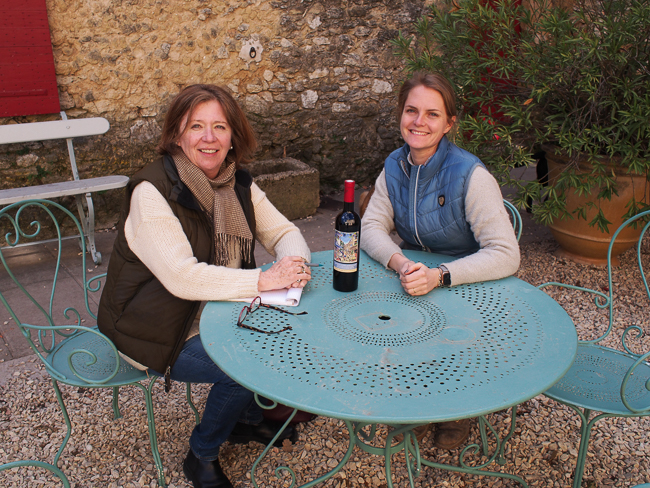
In a heartwarming conversation, the first of many with Madeleine, she told us that she would really like to be a part of what we were doing. She expressed her condolences, as she had earlier, and explained that, while she had not had the pleasure of meeting Alex, she felt a certain affinity with us as she, too, is an only child and her family of three was very close when her mother died at age 40 and Madeleine was just seven years old.
The Artwork. Our spirits were riding high when we reached out to Gérard Isirdi, renowned painter whose atelier is on the main street that runs through the center of the tiny village of Lourmarin (population about 1100). Gérard’s iconic scenes of village life, especially as observed from Café Gaby, are revered around the world. Several of his paintings grace the walls of our home.
We had come to know Isirdi and his wife Christine during our six-month sojourn in the village in 2002. After vacationing in Provence for five years, the possibility arose to enjoy a long stay in Lourmarin. We snapped up the chance for a respite from our busy lives and the opportunity to experience another culture in a place we loved. I wrote and Towny honed his photography skills. Alex, who turned 11 years old in Provence, attended the local elementary school; was a member of the local boys soccer team (as there was no girls team); learned to speak French with, as she always proudly said, a Provençal accent; and she solidified a lovely relationship with Gérard and Christine, that included rendezvous at Café Gaby to paint. As Alex grew older, she would stop by Gérard’s gallery to catch up with him and Christine.
When Alex died, Gérard wrote a beautiful poem for Alex which Towny’s sister read at Alex’s service. We hoped he would be willing to create a painting from which we could have a label made.
I tucked a bottle of Château Barbebelle wine into my bag and we met the Isirdis at Café Gaby. Over pastis, we shared our idea with them. There, where we all had sat with Alex on so many other occasions, not ever imagining that we never would sit with her again, we discussed the tragic loss of such a vibrant person.
Gérard agreed immediately and Christine, echoing Gérard ’s wholehearted support, concurred. There was not a dry eye at the table as we raised our glasses toward heaven.
Perhaps Gérard took an interest in Alex and her artwork because he, also, began painting at a young age. Isirdi, originally from Aubagne en Provence about 21 kilometers (13 miles) northeast of Marseille, was the 11th of 12 children in a family originally from Italy. Isirdi grew up just south of this city, in the village of Roquevaire — known as “la Cité des peintres” – and it was there that he first experimented with painting. In his teens, Isirdi began studying painting with a group collectively called “Peintres de la Vallée de L’Huveaune,” from whom he received much encouragement and with whom he exhibited his work. He often accompanied painters from Roquevaire, part of this group, out into the surrounding countryside and, to this day, Isirdi credits these pleinairistes with profoundly influencing his approach to painting.
From Roquevaire, he went north to Paris and later south to Andalusia and Morocco, all the while painting. In 1975, he returned to Roquevaire for his first solo exhibition.
In 1980, Isirdi discovered the Luberon where he lived for five years in the ruins of a troglodyte farmhouse. Not yet able to sustain himself as a painter, he also worked as a gardener at this time, which Isirdi describes as “tourmentée” (“turbulent”).
It was not until 1990 that Isirdi made the commitment to work full-time as an artist. In 1991, when he was 41 years old, he set up his first studio in Lourmarin. In the same year, he was awarded “Le Prix Albert Camus,” which Isirdi said he saw as a “sign of favorable destiny.” Indeed. He immediately had three major exhibitions: in Annecy (1993), San Francisco (1994), and Geneva (1998). We met Isirdi shortly after the Geneva show, on our first trip to Lourmarin.
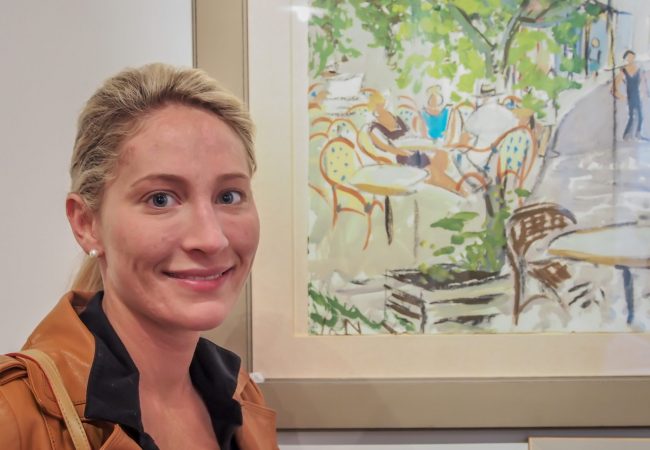
Today, Isirdi’s colorful scenes of Provençal café life hang on the walls of countless homes around the globe. He has the extraordinary ability to capture, in surprisingly few strokes, the character and spirit of a single subject or of an entire village scene. Alex and I, along with good friend Pierre Schott, are in one of those paintings from a few years back. I have no idea if Isirdi ever imagined that his art would be wrapped around a wine bottle.
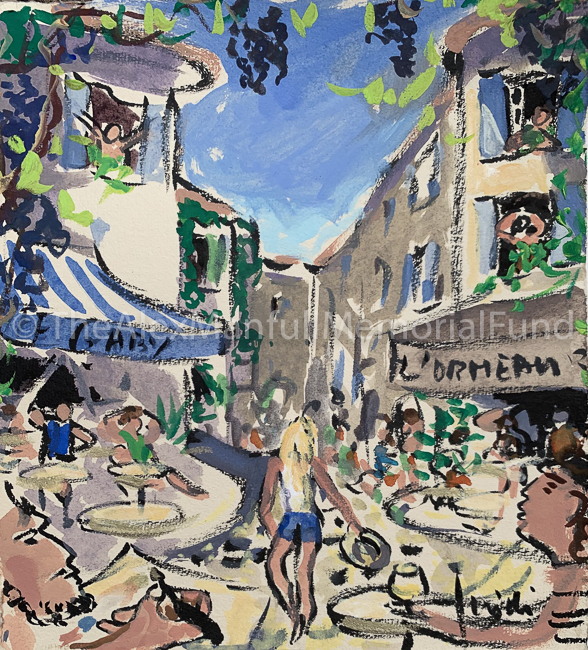
It was not long before Gérard finished the painting. Painting in gouache, as Isirdi often does, he created a bustling café scene, pulsating with life under a brilliant blue sky. Alex is strolling through center and the artist himself seated in the corner, capturing the moment on his paper. It is striking how much life radiates from the painting and yet, of course, the subject at the center of the work has lost her life. Is it her spirit that radiates from the paper? She always said she felt more herself in Lourmarin.
Putting it all together. The alluring painting then needed to be turned into a form from which the labels could be printed. Towny, who has a degree in printing from Rochester Institute of Technology and worked in the printing industry for several decades, unfortunately, had returned home. I was on my own. Christine gave me a crash course on what to be mindful of in order to ensure the lively colors of the painting are translated to the printed label.
By the grace of God (or was it Bacchus?), the reputed best wine label printer in the vast region of Provence – the one Madeleine Premmereur uses as well as many other of the wine producers I know – is in an itsy-bitsy village near Cotignac, about an hour away from Lourmarin. I was heading there the next day to visit an old friend. My lunch partner would understand that we would have to limit our rosé consumption at the table in order to pay a visit to a nearby specialty printer and that she would have to translate.
Impression Varoise d’Étiquettes (better known by the acronym, IVE), the wine label printer, is a very modern operation, located outside the tiny village of Pontevès, way off the main road and well off the GPS grid on my iPhone. I immediately regretted not renting the four-wheel drive car we had considered. (We later learned there is a faster route, but ours added to the sense of adventure.)
As it turned out, the meeting was probably a bit of an adventure for David Bontaz, our contact at IVE, too. The printing vernacular is not part of my friend’s French vocabulary so Towny was on the telephone from Boston with us during most of the conversation. Who knew there were so many styles of wine labels? That, coupled with paper choices, made for lots of decisions. Bontaz, ever patient, was undoubtedly exhausted by the end of our rendezvous, but I was elated that this project was on its way. And I would soon be on my way home with a sense of accomplishment toward fulfilling Alex’s mission.
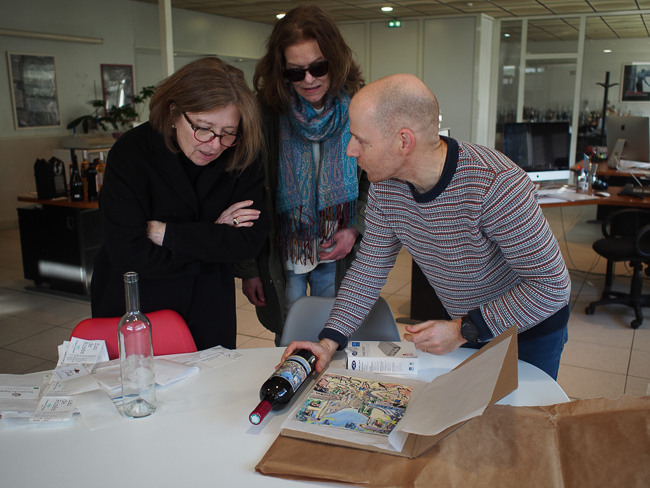
Over the next few months, we worked with a local graphic designer, Susan Kress Hamilton, co-proprietor of Phineas Press in Portsmouth, New Hampshire. Susan Hamilton first met Alex when she was around eight years old and Phineas Press printed some of Alex’s artwork for a juried arts and crafts show. We asked Hamilton to create a label to be affixed under the main label (Isirdi’s work) which would provide the PANDAS messaging. She was also tasked with making pretty a tiny booklet — chock-full of information about Alex, the winery, the painter, PANDAS, and À Table — that would be attached to the bottle. All are beautifully coordinated.https://player.vimeo.com/video/441003134
Meanwhile, there were issues, separate from the havoc that COVID-19 would come to create, that could have threatened the viability of our project. Those tariffs, for example.
On October 18, 2019, shortly after I returned from Europe and my conversations with Madeleine Premmereur, the first tariffs went into effect. As part of a $7.5 billion compensation package awarded by the World Trade Organization (WTO) to the United States over subsidies that allegedly gave European Airbus unfair advantages over the US firm Boeing, the US imposed a 25% tariff on table wines with less than 14 percent alcohol (and on cheese, olive oil, single-malt Scotch, and cashmere sweaters) from France as well as Germany, Spain, and the U.K. This is a 20-year dispute over subsidies that each party argued that the other provided unfair advantages.
Then, in January 2020, the Trump administration threatened retaliatory tariffs of up 100% on all European wines. A month later, the Office of the US Trade Representative (USTR) announced that these additional import taxes would not be imposed (for now). We breathed a collective sigh of relief as a tariff of that magnitude would clearly have sabotaged our project (as well as many sectors of the wine industry, here and abroad). But, apparently, the threat of more tariffs is not dead.
In March, the impact of the COVID-19 pandemic and consequent stay-at-home and quarantine orders led to a global shutdown. Not surprisingly, wineries in France were shut down except for essential jobs, shipping slowed way down around the world, and unloading cargo at some ports was reduced to a snail’s pace. The arrival of our bottles was delayed. Truthfully, this delay ended up having little effect since few people were out shopping anyway. The nation was focused on the horror of COVID-19.
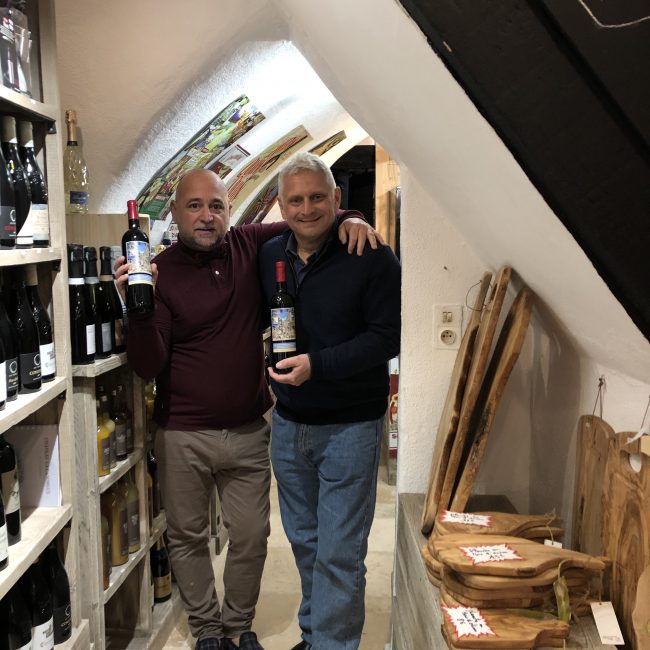
In France, our efforts to raise awareness were – and continue to be — stifled by COVID-19. We had planned an open house event at De La Cuisine Au 20 Wine and Épicerie in Lourmarin. We had hoped to raise awareness in a country where PANDAS and PANS are almost completely unknown (although cases certainly exist). In addition, we wanted to launch the sale of the wine at De La Cuisine Au 20 Wine with some fanfare.
The spring open house and launch in France was looking less and less feasible when Air France cancelled our April flights. Had we gone any earlier, we might have found ourselves on an unexpected extended vacation in France. Now, of course, Americans are, understandably, not able to enter France. At this time, while our open house is indefinitely postponed, the wine is back in the store and will soon be for sale again at De La Cuisine Au 20 Wine and Épicerie in Lourmarin.
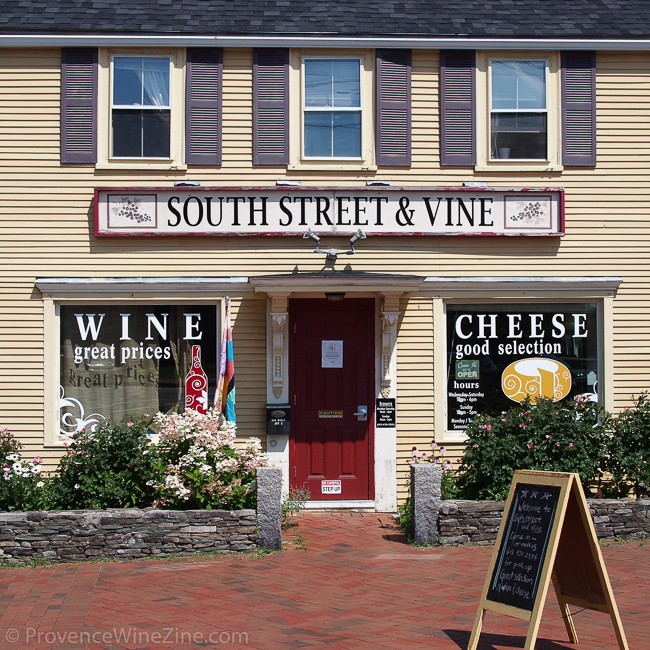
Stateside, I am thrilled to report that beginning Friday, July 31st, this wine will be sold at South Street and Vine Wine and Cheese Shop in Portsmouth, New Hampshire. On that afternoon, from 4:00 to 6:00 p.m., tastes of the wine will be offered, and the wine may be purchased.
Our hope is that those of you who purchase this wine will take it to the table to share with friends and family alongside a meal you love. Coming to the table was our family tradition. It’s where we three – along with our many friends – recounted our day’s activities, expressed our joys and our disappointments, solved problems, talked politics, and had many laughs.
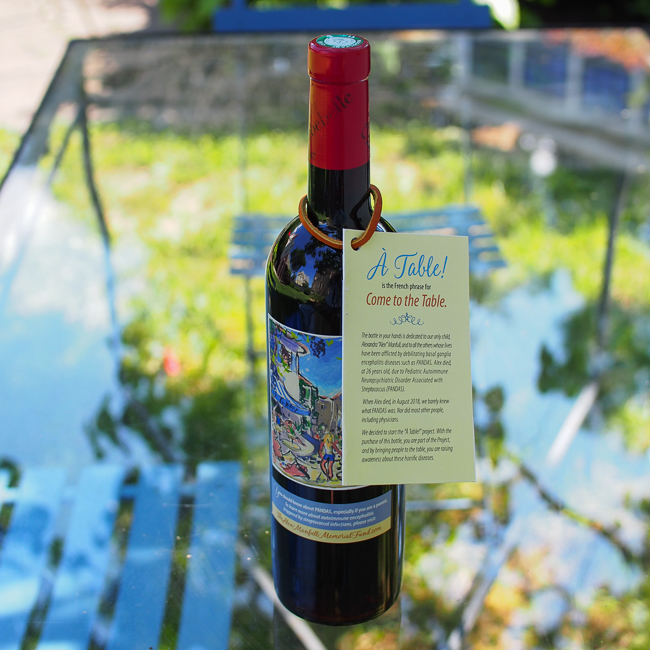
We hope this bottle engenders lively conversation at your table, too, and we hope you are moved to raise your glasses to Alex and all the others who have PANDAS or PANS with the commitment to spread the word about these disorders.
Raise your glass to the defeat of PANDAS and send us a photo that we may post online on Alex’s birthday, September 7th.
Photos can seen on The Alex Manfull Memorial Fund page on PANDASNetwork.org. If you are on Instagram, you can see them on @alexmanfullmemorialfund. If posting on Instagram, please tag @thealexmanfullmemorialfund and use the hashtag #wecametothetable
Thank you for helping to spread the word about PANDAS. We can’t bring back Alex, but we can do our best to make sure that no other person loses his or her life or the years of life it can take to diagnose and treat this horrendous disease. In doing so, we honor Alex by carrying on with the work she had fervently intended to do.
All proceeds from the À Table! will go toward research. If you would like to make a contribution to The Alex Manfull Memorial Fund, you might want to know that her fund is part of PANDAS Network, a 501(c)(3) nonprofit organization, and that all gifts to the fund are tax deductible as allowed by law. Please visit TheAlexManfullMemorialFund.com
————————
Notes:
We are grateful to so many people who helped with À Table! I could not weave all the names into the story, but I would still like to acknowledge their role in bringing this project to fruition: David Scott Allen, Claire Fleming, Lisa Harper, Martin Kolk, Robin Lurie-Meyerkopf, Rick Meyerkopf, Pamela O’Neill, Win Rhoades, Pierre Schott, Patti Thornton, and Patrick Walsh. Whether it was a roadmap through the labyrinthine business of wine, proof reading, or French translations, we benefited from your behind-the-scenes help.
Like nearly everyone around the globe, our initial plans had to change, adjustments made, and immediate aspirations toned down. For now…as we will try again next year. (If you are interested in hosting a dinner in fall 2021 to support PANS/PANDAS research, please let me know.)
To learn more about Alex, please follow this link
To learn more about PANDAS, please follow this link
For more information about purchasing this wine, please leave a comment or contact me at susan@provencewinezine.com
Contact Information:
Château Barbebelle
Route D 543,
13840 Rognes, France
Tel: (33) 4 42 50 22 12
Email: contact@barbebelle.com
Gérard Isirdi
Atelier Isirdi
4 rue Henri de Savornin
84160 Lourmarin, France
Tel : (33) 4 90 08 50 96
Mobile : (33) 6 82 23 28 73
Email: isirdi@wanadoo.fr
De La Cuisine Au 20
20 Rue du Temple
84160 Lourmarin, France
Tel : (33) 9 53 96 96 61
Email: contact@delacuisineau20.com
South Street and Vine
359 Marcy St
Portsmouth, NH 03801
Tel: (603) 430-2984
Email: robin@southstreetandvine.com
